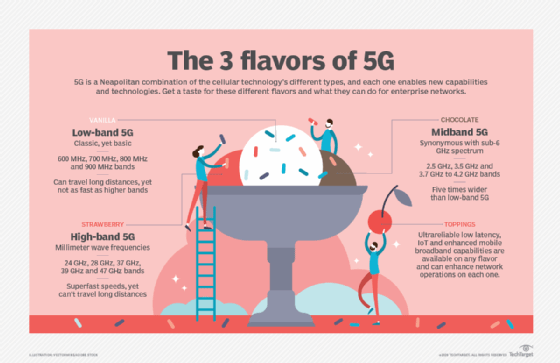The 3 different types of 5G technology for enterprises
5G isn't a single flavor of cellular technology; it's three flavors, and each one can enable advanced capabilities, such as ultrareliable low latency and IoT connectivity.
The fifth generation of cellular technology, 5G, isn't a single flavor. In fact, 5G is more like a Neapolitan mix of three flavors with new, advanced capabilities available to add on to each type.
The different types of 5G comprise the various frequencies on which 5G operates, dubbed low-band, midband and high-band 5G. The distinctions among these flavors relate to the different characteristics of each spectrum, according to Lindsay Notwell, senior vice president of 5G strategy and global carrier operations at Cradlepoint Inc., a networking vendor based in Boise, Idaho, and part of Ericsson.
The respective characteristics of each 5G type aren't inherently new. They build on capabilities of past generations and aim to solve problems those generations created. However, the different types of 5G are notable because they enable advanced applications and techniques that make 5G unique for enterprise networks.
The different types of 5G can be compared to Neapolitan ice cream, a type of ice cream with three separate flavors in one container. Low-band, midband and high-band 5G are similar to vanilla, chocolate and strawberry, respectively. Three major U.S. carriers -- AT&T, T-Mobile and Verizon -- use all three frequency bands.
1. Low-band 5G
Low band is the closest 5G spectrum to 4G and 4G LTE and operates on the closest frequencies to TV and radio stations. That's why it's vanilla: It's classic, everyone's familiar with it and it's fairly basic in terms of advanced frequencies.
 Lindsay Notwell
Lindsay Notwell
This doesn't mean low-band 5G isn't worthwhile, though. Low-band 5G is 10 times faster than 4G speeds, Notwell said, and this type of 5G can travel long distances. Some TV stations still use similar frequency bands because of the bands' abilities to cover large areas. Low-band 5G ranges from 600 MHz to 900 MHz, according to the Federal Communications Commission (FCC).
However, low-band 5G isn't as fast as the other flavors, which is why it can travel so far. Low-band 5G has low bandwidth. It can travel far because it has a lower capacity to carry data than higher frequencies.
"It's sort of a two-edged sword," Notwell said. "The low band has great characteristics -- reach, frequency and penetration -- but it's just not very wide."
2. Midband 5G
Midband 5G is like chocolate ice cream: a bit more advanced than vanilla low band yet not the most hyped of the different types of 5G. Midband is generally synonymous with the sub-6 GHz spectrum, as it ranges from 2.5 GHz, 3.5 GHz and 3.7 GHz to 4.2 GHz bands. Midband 5G spectrum is five times as wide as low-band spectrum, Notwell said.
While midband 5G is wider than low-band 5G with more capacity to transport larger amounts of data, it can't travel as far. Buildings and other solid objects can affect higher ranges of midband 5G, although that permeation issue more prominently impedes high-band 5G.
3. High-band 5G and millimeter wave
High-band 5G is effectively the opposite of low-band 5G: It can't travel far, but it has the superfast speeds that result from 5G's most touted benefits. High-band 5G correlates to strawberry ice cream, as it adds a distinctive flavor to the Neapolitan combination: faster speed. The FCC said high-band 5G includes 24 GHz, 28 GHz, 37 GHz, 39 GHz and 47 GHz bands.
Just as strawberry ice cream contains tiny pieces of strawberry, high-band 5G includes an added surprise: millimeter wave (mmWave), the spectrum between 30 GHz and 300 GHz that provides high-speed connectivity and faster download speeds. These capabilities -- and mmWave's high bandwidth and ability to carry more data between destinations -- have increased global interest in 5G technology.
MmWave is also the only type of 5G with potentially different use cases than the other flavors. For example, data centers may require mmWave for failover, as data centers are fed by fiber only because the medium is fast and reliable, Notwell said. MmWave would support the level of performance and speed that data centers require more than low-band or midband 5G. Overall, though, use cases don't vary much by spectrum type.
One of the biggest challenges with high-band 5G for both carriers and enterprises is mmWave's line-of-sight travel, which limits how far the frequency can travel. Even heavy rainfall, for example, could impede mmWave. Because of this limitation, proper installation is critical for an organization's successful 5G deployment, Notwell said.
"If all we had to rely on was millimeter wave, that would be a problem," Notwell said. "But what we're seeing is newer technologies enabling 4G and 5G to work in the same frequency. That's called dynamic spectrum sharing."

Other assorted 5G capabilities
Dynamic spectrum sharing is one capability the different types of 5G can use -- it's like an assorted topping available for any flavor of 5G technology. Other toppings and capabilities include ultrareliable low latency, IoT capabilities and enhanced mobile broadband.
Dynamic spectrum sharing
Thanks to dynamic spectrum sharing, the different types of 5G frequencies can exist on the same spectrum as 4G. This sharing has become more prevalent with 2G and 3G sunsets, as carriers shut down spectrums they allocated to 2G or 3G technologies and invest in spectrums that 4G and 5G could operate on together, Notwell said.
Dynamic spectrum sharing can benefit organizations that employ 4G technology already and aren't sure if a 5G investment would be worthwhile. 4G can still serve many use cases. The strategy for many organizations is to "deploy with 4G and plug in 5G when and where you can," Notwell said.
So, for those organizations that want to add a scoop of coffee ice cream -- or 4G -- to their 5G Neapolitan dessert, dynamic spectrum sharing enables that combination.
Ultrareliable low latency
Each type of 5G technology supports ultrareliable low-latency connections, which enable quick responses to requests and benefit areas such as automation and video conferencing.
Further, this ultrareliable low-latency connectivity can save organizations money, as it enables remote communication, so organizations wouldn't pay as much to fly employees to job fairs or conferences, Notwell said. Communication could be instantaneous with 5G -- even without a person's physical presence. This connectivity can also enhance facial recognition and video surveillance capabilities.
IoT capabilities
The three different types of 5G can enable massive machine-type communication, which is the ability for machines to communicate with one another without human intervention, like IoT. In particular, 5G enables narrowband IoT, a low-power IoT technology that can benefit and support a large amount of IoT devices.
Narrowband IoT also enhances mobile device battery life, so an IoT sensor battery could last up to 10 years, Notwell said. Also, if an organization has disparate systems for all its connected devices, 5G could shrink those to one network. Each type of 5G aims to quickly and reliably support all connected devices on a single 5G network with these new capabilities.
Enhanced mobile broadband
This capability is exactly how it sounds: Enhanced mobile broadband improves standard mobile broadband operations. Enhanced mobile broadband can also cut an organization's costs on its wired connectivity.
This enhanced broadband is the reason experts have questioned whether 5G will eradicate Wi-Fi because enhanced mobile broadband offers faster, more flexible and more reliable connectivity than traditional cellular technology and Wi-Fi connectivity.
"You'll see this dramatic change in wide area networking -- the wired world -- into one that's wireless because it gives the freedom of place and freedom of time," Notwell said. "[A big] problem retailers have is getting the wiring install and store opening date to align. Well, wireless is there already, so I can just turn it on."
Editor's note: This article was updated to reflect changes in the carriers' use of 5G bands.








